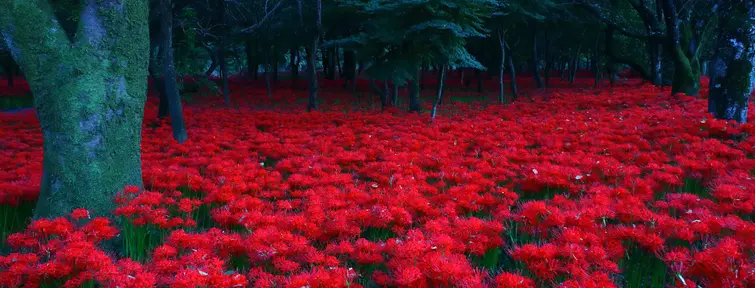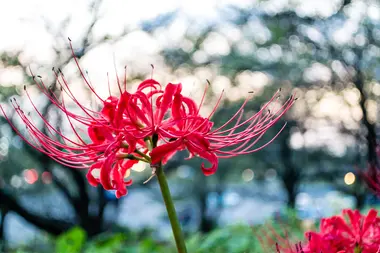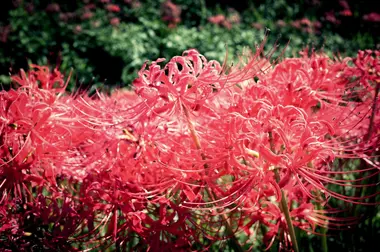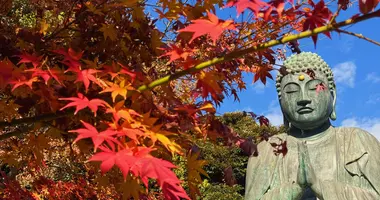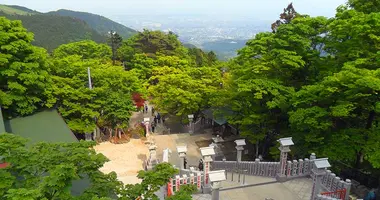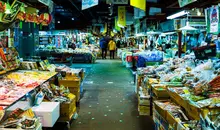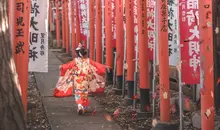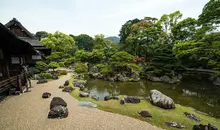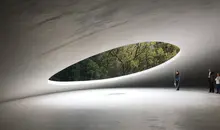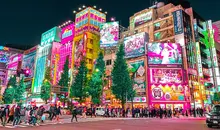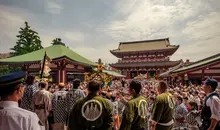The 10 best places to see spider lilies in Japan
- Published on : 25/09/2025
- by : Joshua
- Youtube
With their distinct appearance, spider lilies (known as Higanbana or Manjushage in Japanese) make for a unique sight in Japan when they bloom in early autumn. Take a look at our favorite places in the country to see these unique flowers!
With their distinct shape and striking color, spider lilies garner a special sort of attention throughout many of the world's cultures. In Japan, they are known as Higanbana (彼岸花) and have a strong link to Buddhist traditions, morbidly representing death but simultaneously the cycle of life and the beauty of impermanence. In fact, within Japanese Buddhist folklore, their blooming along the Sanzu River is significant, as this is the river that is said to flow between the realm of the living and the dead.
The flowers bloom from September to October, which also makes them synonymous with the Autumn Equinox, and throughout many parts of Japan, they lace through the natural scenery, creating sweeping carpets of bright crimson. With such a unique sight, many flock to different parts of the archipelago to see these distinct flowers bloom. Here are some of our favorite places to see spider lilies throughout Japan!
Kinchakuda Spider Lily Park (Saitama Prefecture)
125-2, Oaza Komahongo, Hidaka-shi, Saitama
Kinchakuda Spider Lily Park in Saitama Prefecture is the most well-known site in Japan for seeing these flowers in autumn. The ground is home to over 5 million (yes, million) spider lilies that grow wildly, often enveloping entire fields in merlot shades. This striking scene makes the park very popular for photoshoots. Aside from the aforementioned Higanbana, spider lilies are also referred to as Manushage in Japanese. During the blooming season, the Manjushage Festival is held with vendors and performances to commemorate the changing season.
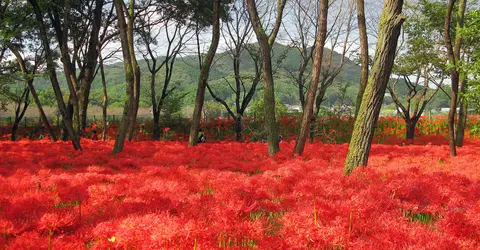
Kinchakuda spider lilies
@京浜にけ on Wikimedia
Terasaka Rice Terrace (Saitama Prefecture)
1846 Yokoze, Chichibu District, Saitama 368-0072
Also located in Saitama, Terasaka is a series of rice paddy terraces that cascade along the countryside landscape. They are a spectacle throughout the seasons, and during early autumn, spider lilies line the edges of the paddies, creating a scene of varying shades of green with splashes of color in between. Here, both red and white spider lilies grow, with rolling mountains in the background. This location is best reached via car.
Order your official license translation and drive around Japan!
While most visitors can drive in Japan with an international driving permit, those with licenses issued by France, Switzerland, Germany, Belgium, Monaco or Taiwan require an official Japanese translation! Read more and order your translation to drive around Japan!
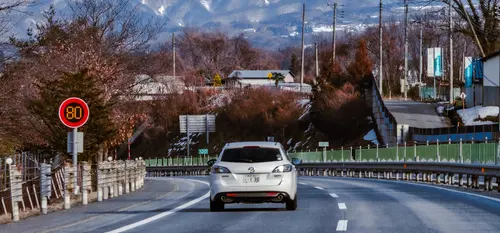
Route dans la préfecture de Gunma
©samir-sayek via Unsplash
Butsuryu-ji Temple (Nara Prefecture)
1684 Haibaraakabane, Uda, Nara 633-0213
Butsuryu-ji Temple in Nara Prefecture dates back to the year 850 A.D. and was built by a disciple of the famous Buddhist monk Kukai. The age of the temple shows with elegant patina on its structures and moss overgrowth, but complementing this atmosphere are the bright glow of crimson spider lilies. These flowers accent the stone stairs that go up the hill to the temple gate, creating a sort of “red carpet” for visitors. There is a bus that goes to the temple from Haibara Station in Uda City.
Gongendo Koen (Saitama Prefecture)
996 Gongendo, Satte, Saitama 340-0112
Another idealistic spot for spider lilies located in Saitama Prefecture, Gongendo Koen is one of the most popular and lauded parks in the entire Kanto area. Indeed, the park is visited throughout the seasons, and Gogendo Koen is very well known for its cherry blossom trees in spring. However, during fall, the calming blush tones of sakura are traded in for the bold reds of spider lilies. These spider lilies were planted back in the year 2000, and every year, these 3 million flowers are celebrated with their Manjushage Festival during the blooming season.
Yakachigawa River (Aichi Prefecture)
- 〒475-0001 1-10-1 Yanabe Nishimachi, Handa-City, Aichi Prefecture, Japan
The Yakachigawa River that runs through Handa City in Aichi Prefecture has a 2 km stretch where the banks are accentuated with the bright red of red spider lilies. On occasion, white spider lilies also bloom, and finding one is a bit of a treat amongst the sea of red. This area was depicted in the early 20th-century Japanese fairytale “Gon, the Little Fox,” written by Nankichi Niimi (who originally hailed from Handa City). There is a museum within the city in dedication to Niimi (called the Nankichi Niimi Memorial Museum) right by the river where some of the densest flower growth can be seen.
Haguroyama Park (Miyagi Prefecture)
Miyagi Osaki-shi Furukawa Kono Haguro 72-1
Located in Osaki City, in Miyagi Prefecture, Haguroyama Park is home to some of the most picturesque scenes for spider lilies. The flowers line the rolling slopes of the park grounds and during sunset, light rays will peer through the trees of the area and illuminate the cascades of spider lilies. At night, the park illuminates the flowers during the blooming season, making it a great place to visit throughout the day.
Anao-ji Temple (Kyoto Prefecture)
〒621-0029 Kyoto, Kameoka, Sogabecho Anao, Higashinotsuji−46
Anao-ji in Kyoto is the 21st temple that is part of the Saigoku Kannon Pilgrimage. It is located in a relatively residential area and its internal garden is one of the most treasured in all of Kyoto. However, outside of the temple are rice fields, and along the edges of these rice fields are the spider lilies. The view of the flowers against the backdrop of the rice fields and local homes is one that many may not see if they only stay in the center of the city. Coming out to Anao-ji entails going out to JR Kameoka Station and then taking the Keihan Kyoto Kotsu Bus to the Anaojimae Bus Stop. From here it is a 10-minute walk.
Koshikawa Korakuen (Tokyo)
1 Chome-6-6 Koraku, Bunkyo City, Tokyo 112-0004
You don’t need to go out all the way to the countryside to appreciate the spider lilies in Japan! Located in central Tokyo in the Bunkyo ward, Koshikawa Korakuen offers both great history and beautiful scenery. The garden is one of the oldest in the capital, dating all the way back to the Edo Period and boasts great sections of spider lilies during autumn. Though the environment within the garden is tranquil, skyscrapers and urban architecture line the background, reminding you of your presence within the most populated city in the world. Koshikawa Korakuen is located right next to the famous Tokyo Dome, where the Tokyo Yomimuri Giants baseball team plays and a venue for some of the country’s most popular musical acts.
Explore the Japanese capital of Tokyo!
Explore Tokyo with help from one of our expert guides!

Tokyo Tower
@mako Makt
Tsuzura Rice Paddies (Fukuoka Prefecture)
Tsuzura, Niikawa, Ukihamachi, Ukiha City, Fukuoka
Listed as one of the top 100 rice terraces in Japan, the Tsuzura Rice Paddies are located among a local farming community. During fall, the spider lilies that line the edges of the paddies create a majestic scene that contrasts the golden hues of the ripening rice plants. The dynamic geography of the area makes for great photographs! This location is most easily reached via car, 25 minutes from the Oita Expressway.
Gugyo-ji Temple (Ibaraki Prefecture)
Ibaraki Prefecture, Joso, Toyookamachi-ko 1
At Gugyo-ji Temple in Ibaraki Prefecture, the spirit of spider lilies and their role in Buddhist folklore stands strong. All through the temple grounds, both red and white and even yellow spider lilies illuminate the grounds with striking colors. The way they grow seems both chaotic and harmonious at the same time. Spider lilies are often even used to decorate shrine and temple facilities, emphasizing the importance of the flower to the religious site.
To read more about Japan and Japanese travel, be sure to subscribe to our newsletter and follow us on Instagram!
Travel across Japan by Shinkansen and more with the Japan Rail Pass!
Unlimited access across the JR rail network for 7, 14, or 21 days!

